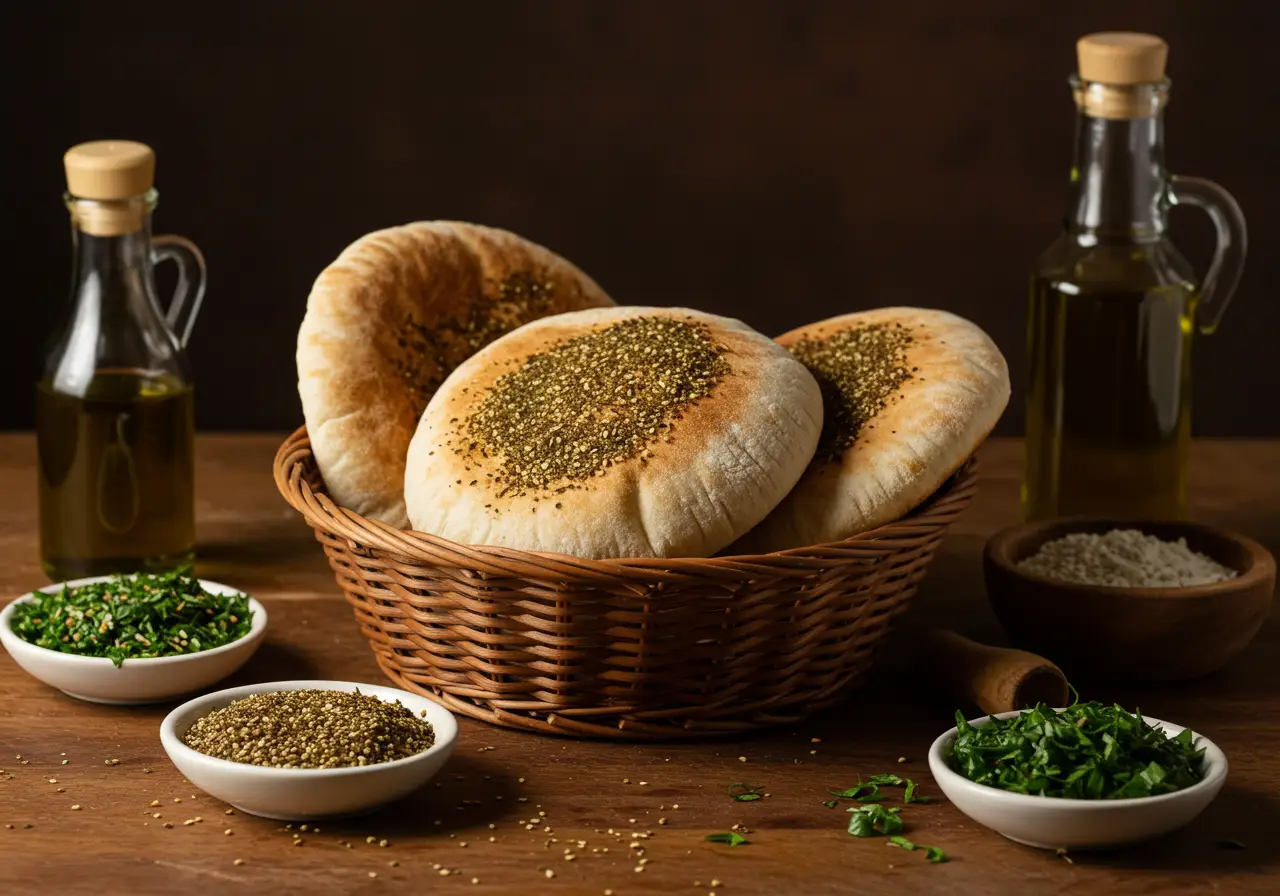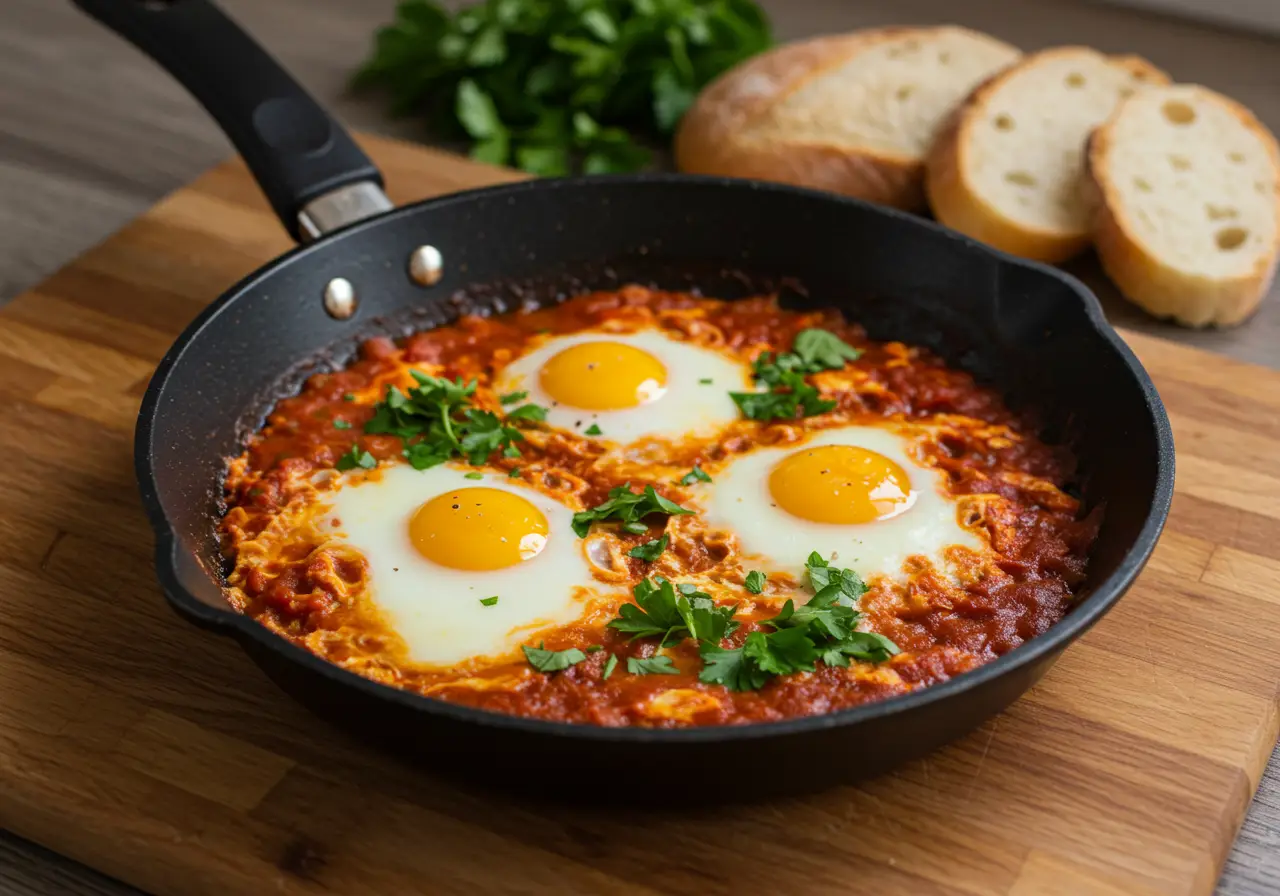When it comes to breakfast, Arabic cuisine offers a feast of flavors, textures, and aromas that awaken your senses and set the tone for the day ahead. Whether you’re preparing a traditional Middle Eastern breakfast, trying authentic Arab breakfast dishes, or exploring Lebanese breakfast ideas, these recipes bring warmth and joy to the table.
From rich spreads of olives, cheeses, and fresh bread to hearty dishes like shakshuka and ful medames, an Arabic breakfast isn’t just a meal—it’s a cultural experience. But why are these breakfasts so special, and what makes them stand out from the rest? Let’s dive into the delicious world of Arabic breakfast food recipes and uncover the secrets to creating a morning meal that everyone will love.
Table of Contents
The Rich Tradition of Arabic Breakfasts
Arabic breakfasts have a deep-rooted history in the Middle East, where food is a celebration of community and hospitality. These meals are all about sharing, with vibrant platters designed to bring people together around the table. The focus is on fresh, wholesome ingredients that reflect the season, ensuring every bite is packed with flavor.
Unlike rushed breakfasts of cereal or toast, Arabic breakfasts are meant to be savored. Imagine sitting at a table with warm pita bread, creamy labneh, and a sprinkle of zaatar. Pair that with spiced tea or Arabic coffee, and you’ve got the perfect way to start your day.
Why Arabic Breakfasts Are Unique
What sets an Arab breakfast apart? It’s the combination of simplicity and richness. Arabic breakfasts prioritize natural ingredients—think olives, herbs, and honey—yet offer bold flavors through carefully chosen spices.
For instance, a Lebanese breakfast food spread might include manakish (a flatbread topped with zaatar), fresh tomatoes, cucumbers, and olive oil. Each element is flavorful on its own but comes together beautifully when shared.
The Role of Fresh and Seasonal Ingredients
Arabic cuisine revolves around freshness. Seasonal vegetables like cucumbers and tomatoes, locally made cheeses, and fresh herbs are staples of any Arabic breakfast. These ingredients are not just healthier but also tastier, ensuring every dish feels vibrant and satisfying.
Pro Tip: When preparing Middle Eastern breakfast dishes, always choose the freshest produce available—it makes all the difference!
“Freshness is the heart of Arabic breakfasts—it’s what turns simple dishes into unforgettable meals.”
Essential Ingredients in Arabic Breakfast Recipes
Before we get into the recipes, let’s talk about the key ingredients that define an Arabic breakfast. These staples are the foundation of the most popular dishes and can easily be found in most grocery stores or Middle Eastern markets.
Fresh Bread: Pita, Saj, and More

Bread is an essential part of an Arab breakfast, acting as the perfect vehicle for dips, spreads, and toppings. Common types of bread include:
- Pita Bread: Soft, round, and perfect for scooping.
- Saj Bread: Thin and slightly crispy, ideal for wraps.
- Manakish Dough: Often baked with zaatar or cheese for a savory treat.
Olive Oil, Zaatar, and Labneh: Staples of the Table
No Arabic breakfast is complete without olive oil, zaatar, and labneh:
- Olive Oil: Drizzle it over bread or use it as a dip—it’s rich and flavorful.
- Zaatar: A blend of thyme, sesame seeds, and sumac, this spice mix adds a tangy kick.
- Labneh: A creamy, tangy yogurt spread that pairs beautifully with vegetables or bread.
“In Arabic cuisine, olive oil isn’t just an ingredient; it’s a symbol of heritage and love.”
Herbs, Spices, and Flavor Boosters
Spices like sumac, cumin, and cinnamon are widely used in Middle Eastern breakfast dishes to create depth and warmth. Fresh herbs like parsley, mint, and coriander bring brightness to salads and dips.
Popular Breakfast Cheeses in the Arab World
Cheese lovers will be delighted by the variety in Arab breakfast spreads. Favorites include:
- Akkawi: A salty, soft white cheese often served with olives.
- Halloumi: A semi-hard cheese that’s perfect for grilling or frying.
- Nabulsi Cheese: Known for its mild flavor, it pairs well with sweet or savory dishes.
Classic Arabic Breakfast Food Recipes
Now that you know the essentials, let’s dive into some classic recipes that showcase the beauty of Arabic breakfast food. These dishes are easy to make, delicious, and perfect for sharing.

Recipe 1: Shakshuka (Eggs in Spiced Tomato Sauce)
Shakshuka is a Middle Eastern breakfast favorite that combines poached eggs with a rich, spiced tomato sauce. It’s hearty, flavorful, and great for dipping bread.
Ingredients:
- Eggs (4–6)
- Tomatoes (4, chopped)
- Onion (1, diced)
- Garlic (3 cloves, minced)
- Spices: Cumin, paprika, and chili flakes
- Olive oil, salt, and pepper
Instructions:
- Heat olive oil in a pan and sauté onions and garlic.
- Add tomatoes and spices, cooking until the mixture thickens.
- Make small wells in the sauce and crack eggs into them.
- Cover and cook until the eggs are set. Serve with warm bread.
Recipe 2: Ful Medames (Stewed Fava Beans)
Ful medames is a hearty dish made from fava beans, olive oil, and spices. It’s a must-have in any Middle Eastern breakfast spread.
Ingredients:
- Cooked fava beans (1 can or 2 cups)
- Garlic (1 clove, minced)
- Lemon juice (2 tbsp)
- Olive oil (3 tbsp)
- Optional: Chopped parsley and chili flakes
Instructions:
- Mash the beans lightly with a fork while heating in a pan.
- Add garlic, lemon juice, and olive oil. Stir well.
- Top with parsley and chili flakes before serving.
Recipe 3: Manakish (Zaatar Flatbread)
Manakish is a delicious flatbread topped with zaatar and olive oil. It’s a staple in Lebanese breakfast food spreads.
Ingredients:
- Flatbread dough (store-bought or homemade)
- Zaatar (2 tbsp)
- Olive oil (2 tbsp)
Instructions:
- Roll out the dough into thin circles.
- Mix zaatar and olive oil to form a paste. Spread it over the dough.
- Bake at 375°F (190°C) for 8–10 minutes.
Recipe 4: Balaleet (Sweet Vermicelli with Eggs)
Balaleet is a sweet and savory dish popular in Gulf Arab countries. It combines sweetened vermicelli noodles with spiced eggs.
Ingredients:
- Vermicelli noodles (1 cup)
- Sugar (2 tbsp)
- Cardamom and saffron (a pinch of each)
- Eggs (2, scrambled)
Instructions:
- Cook vermicelli and mix with sugar, cardamom, and saffron.
- Scramble eggs and serve them on top of the noodles.
Innovative Twists on Traditional Recipes
While traditional Arabic breakfast food recipes are timeless and delicious, adding a modern twist can keep your breakfast table exciting. These ideas blend classic flavors with creative approaches, making them perfect for any occasion.

Avocado and Zaatar Toast
If you’re an avocado toast lover, this Middle Eastern-inspired version will become your new favorite. It’s a blend of creamy avocado, tangy zaatar, and a drizzle of olive oil.
Ingredients:
- Sliced bread (toasted)
- Ripe avocado (1, mashed)
- Zaatar (1 tsp)
- Olive oil (1 tbsp)
Instructions:
- Spread mashed avocado over toasted bread.
- Sprinkle zaatar generously and drizzle with olive oil.
- Add a pinch of salt or chili flakes for extra flavor.
“This is the perfect fusion of modern brunch trends with authentic Arabic flavors!”
Labneh Pancakes with Honey
Labneh pancakes are a fluffy, tangy alternative to classic pancakes, topped with a drizzle of honey for sweetness. This dish brings the richness of Lebanese breakfast ideas to the table in a unique way.
Ingredients:
- Pancake batter (store-bought or homemade)
- Labneh (1/2 cup)
- Honey (for drizzling)
- Crushed pistachios (optional)
Instructions:
- Add labneh to your pancake batter and mix well.
- Cook pancakes as usual and top with honey and pistachios.
Breakfast Bowls Inspired by Arabic Flavors
A breakfast bowl packed with Arabic ingredients is a great way to enjoy variety in one dish. Layer elements like hummus, falafel, fresh vegetables, and boiled eggs for a nutritious and visually appealing meal.
Ingredients:
- Hummus (1/2 cup)
- Cooked falafel (4 pieces)
- Cherry tomatoes, cucumbers, and olives (chopped)
- Hard-boiled eggs (2, sliced)
Instructions:
- Arrange hummus at the base of the bowl.
- Add falafel, vegetables, and eggs on top.
- Drizzle with olive oil and sprinkle with parsley.
Common Problems When Making Arabic Breakfasts and Solutions
Cooking Arabic breakfast food recipes at home can sometimes present challenges. Here are common issues and tips to overcome them, ensuring your dishes are as delicious as they are authentic.
How to Avoid Overcooking Shakshuka Eggs
Overcooked eggs can ruin the texture of shakshuka. To prevent this:
- Use Medium Heat: Simmer the sauce gently to avoid scorching.
- Cover the Pan: This helps cook the eggs evenly without drying them out.
- Monitor Closely: Remove from heat as soon as the egg whites are set but the yolks are still runny.
Fixing Dry or Bland Ful Medames
Ful medames should be creamy and full of flavor. If it turns out dry or bland:
- Add more olive oil to improve texture.
- Season generously with salt, lemon juice, and garlic.
- Mash the beans slightly to create a smoother consistency.
Troubleshooting Dough for Manakish
Perfect manakish dough can be tricky. Here’s how to handle common issues:
- Sticky Dough: Add a little flour, but don’t overdo it. The dough should remain soft.
- Dough That Won’t Rise: Ensure your yeast is active and your water is warm but not hot.
- Dry Flatbread: Brush the dough with olive oil before baking to keep it moist.
The Art of Presentation: How to Serve an Arabic Breakfast
Serving an Arab breakfast is as much about presentation as it is about flavor. The goal is to create a feast for the eyes and the taste buds.
Arranging a Mezze-Style Breakfast Spread

A mezze spread is a stunning way to serve an Arabic breakfast. Here’s how to arrange it:
- Use small bowls for dips like hummus, labneh, and baba ghanoush.
- Place olives, fresh vegetables, and cheese on a wooden board.
- Stack warm pita or saj bread in a basket lined with a cloth to keep it soft.
“An Arabic breakfast spread should feel like a treasure chest—every bite is a delightful discovery.”
Choosing the Right Serving Dishes
Opt for rustic, earthy plates and bowls that complement the vibrant colors of your food. Clay or ceramic dishes work well for presenting Middle Eastern breakfast items like ful medames or shakshuka.
Pairing Beverages with Arabic Breakfast Foods
The drinks you serve can elevate your breakfast experience. Popular options include:
- Arabic Coffee (Qahwa): Lightly spiced with cardamom for a fragrant start to your day.
- Mint Tea: Fresh and soothing, this pairs beautifully with savory dishes.
- Jallab: A sweet, date-based drink often served with crushed ice and pine nuts.
Health Benefits of Arabic Breakfast Recipes
Arabic breakfasts are not just delicious—they’re also nutritious, offering a balanced start to your day.

Nutritional Value of Traditional Ingredients
- Olive Oil: Packed with healthy fats that support heart health.
- Legumes: Ful medames and hummus are rich in protein and fiber, keeping you full for longer.
- Vegetables: Fresh tomatoes, cucumbers, and herbs provide essential vitamins.
The Role of Olive Oil and Fresh Herbs
Olive oil and herbs like parsley and mint are staples in Lebanese breakfast ideas, adding both flavor and health benefits. Drizzle olive oil over labneh or shakshuka to boost the dish’s richness while supporting good cholesterol levels.
Balanced Flavors for a Healthy Start
Arabic breakfasts focus on balance—pairing savory elements like olives and cheese with lighter options like fresh vegetables and yogurt. This combination prevents sugar spikes and keeps energy levels steady throughout the day.
Tips for Hosting an Arabic Breakfast Gathering
Hosting an Arabic breakfast is not just about serving food—it’s about creating an inviting, warm atmosphere that brings people together. Here are some practical tips to make your gathering a success.
Planning the Menu
When planning a menu for an Arabic breakfast, variety is key. Aim to include a mix of the following:
- Dips and Spreads: Labneh, hummus, baba ghanoush.
- Breads: Warm pita, saj, or manakish.
- Hearty Dishes: Shakshuka, ful medames, or fatteh (toasted bread with chickpeas and yogurt).
- Fresh Additions: Sliced cucumbers, tomatoes, olives, and fresh mint leaves.
- Sweet Options: Honey, date syrup, or Balaleet (sweet vermicelli).
“Think of your menu as a mosaic—each dish is a small, beautiful piece that completes the picture.”
Preparing Ahead for a Stress-Free Morning
Hosting a breakfast can be hectic, but preparation is your best friend.
- Make Dips the Night Before: Hummus and labneh can be prepped ahead and stored in airtight containers.
- Prep Vegetables: Wash, chop, and store cucumbers and tomatoes in the fridge overnight.
- Pre-Bake Bread: If making manakish or saj, bake them the evening before and reheat gently in the morning.
Engaging Guests with Interactive Food Experiences
One of the joys of an Arab breakfast is the interactive aspect. Encourage guests to build their plates with a DIY approach:
- Set up a manakish station where guests can top flatbread with zaatar, cheese, or other toppings before baking.
- Arrange a mezze bar with bowls of dips, fresh veggies, and pita.
These setups not only make hosting easier but also allow guests to customize their plates, making the meal more fun and memorable.
Frequently Asked Questions About Arabic Breakfast Foods
Curious about the traditions, foods, and cultural aspects of Arabic breakfast food recipes? Here are answers to some common questions.
What Is a Typical Lebanese Breakfast?
A Lebanese breakfast often includes fresh and flavorful items served family-style. Key dishes include:
- Manakish: Flatbread topped with zaatar, cheese, or ground meat.
- Labneh: Creamy strained yogurt served with olive oil and fresh herbs.
- Hummus and Baba Ghanoush: Dips made from chickpeas and eggplant, respectively.
- Fresh Vegetables and Olives: Sliced cucumbers, tomatoes, and tangy olives.
Pair these with a cup of strong Arabic coffee or mint tea for a complete experience.
What Do They Eat for Breakfast in Saudi Arabia?
Breakfast in Saudi Arabia blends hearty and simple dishes. Staples include:
- Mutabbaq: A stuffed pastry often filled with minced meat or vegetables.
- Khubz: Traditional Saudi bread served with honey, date syrup, or cheese.
- Harees: A porridge-like dish made from cracked wheat and meat, popular during Ramadan.
- Dates and Milk: A simple, wholesome option enjoyed by many.
What Is a Traditional Arab Breakfast?
A traditional Arab breakfast is a feast of variety, combining savory and sweet flavors. It typically features:
- Ful Medames: A hearty dish of stewed fava beans.
- Shakshuka: Poached eggs in a spiced tomato sauce.
- Cheeses: Halloumi, Nabulsi, or Akkawi.
- Fresh Bread: Pita or saj for dipping and scooping.
- Accompaniments: Olives, zaatar, olive oil, and fresh herbs.
This communal style of eating highlights the importance of family and sharing in Arab culture.
What Is Breakfast Food in Islam?
Islamic traditions don’t dictate specific breakfast foods but emphasize starting the day with wholesome and nourishing meals. Many Muslims enjoy Middle Eastern breakfast staples like:
- Dates: A Sunnah food often eaten at Suhoor (pre-dawn meal during Ramadan).
- Fresh Fruits and Vegetables: Simple, healthy options.
- Porridge or Grains: Items like harees or rice-based dishes are common.
Eating with moderation and gratitude aligns with Islamic values, making any breakfast a spiritual act.
Conclusion: Bringing the Warmth of Arabic Breakfast to Your Table
Arabic breakfast food recipes are a celebration of culture, flavor, and community. With dishes like shakshuka, ful medames, and manakish, your mornings can be transformed into a vibrant feast. Whether you’re hosting a mezze-style spread or enjoying a quiet breakfast with labneh and zaatar, these recipes bring the heart of the Middle East to your table.
If you’re inspired to try more breakfast ideas, take a look at these related recipes:
- Explore versatile ideas with this guide on puff pastry breakfast recipes to add a buttery twist to your table.
- For a creative bowl-based option, check out this recipe for a breakfast bowl infused with fresh flavors.
- Discover additional inspiration with these easy breakfast recipes that anyone can make.
By mixing tradition with creativity, you can create breakfast spreads that everyone will enjoy. Start experimenting today and let the rich flavors of Arabic cuisine shine on your table! 😊

